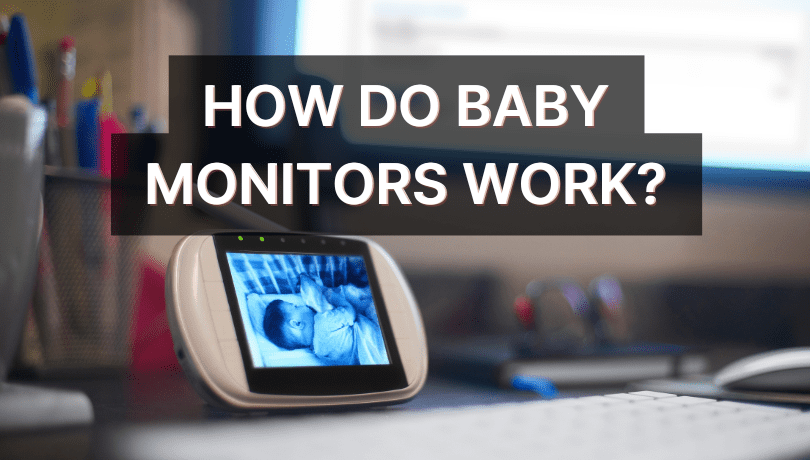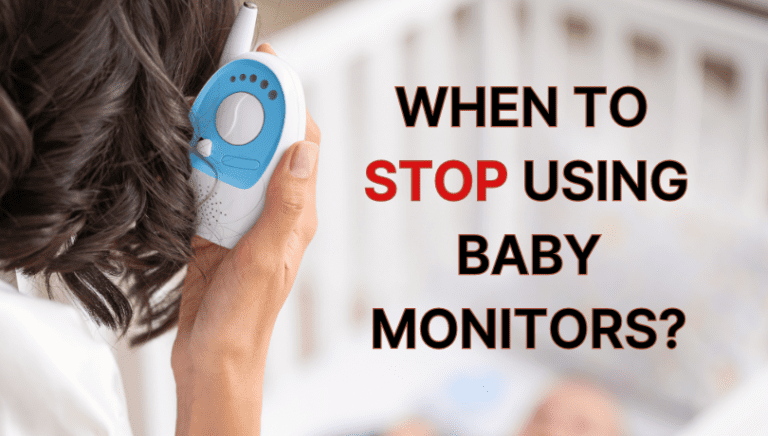How Do Baby Monitors Work? 3 Types & Safety Tips
Parenthood is full of ups and downs, where you adopt new habits, develop new feelings, and happily face tough times. And even the smallest support tool can make a difference in a parent’s life as they welcome a new baby. Even for experienced parents, a new child brings on unique challenges.
That’s where your small but trusty support tool called a baby monitor comes in. I would be so lost without my baby monitor! With 6 kids running around, I need to know where everyone is.
Without a monitor, it would also not be simple to care for my two young babies simultaneously, with my entire family. So, clearly, they are useful devices to have. But how do baby monitors work, do you know?
Join me in discovering how they function, the key components behind them, safety points, and more. Let’s get the ball rolling!
Table of Contents

Two Key Components: Transmitter and Receiver
First, let’s familiarize ourselves with the two main components working together to track your baby’s activities — a transmitter and a receiver.
- The transmitter or child unit has a microphone that sends your baby’s voice to the receiver, also called the parent unit.
- Video baby monitors have a camera attached to the microphone, letting you have a visual of your baby too.
The technology behind the transmission of signals may vary, which you will learn about further in this post.
Additionally, smart baby monitors work on app integration, strengthening monitoring capabilities. For example, families using a Wi-Fi baby monitor download companion apps and use monitoring features like weekly feed reports, milestones recording, etc.
How Do Baby Monitors Work?
Simply put, baby monitors are categorized into three types:
- Audio Baby Monitors
- Video Baby Monitors (includes Wi-Fi and Non-Wi-Fi ones)
- Movement Baby Monitors
Let’s get into detail about what they are and how they work.
1. Audio Baby Monitors
As the name implies, this is a sound-only baby monitor.

- Audio baby monitors work on a radio signal, like FM radio. But while listening, you may encounter static noises too.
- It’s because they use the oldest analog technology, breaking sounds into small bits before transmitting them to the receiver.
However, many families still use them while traveling since they are reasonably priced and portable.
2. Video Baby Monitors
Video baby monitors have a screen that lets you watch your baby’s actions. Also, they cover more range than their analog/audio counterparts.
- These monitors came into life in 1999 and stole the hearts of parents because they could watch their little ones.
- They’re a popular choice because they feature zoom, pan, tilt, and night mode options.
Video baby monitors can be further broken down into 3 types: Wi-Fi-Based, non-Wi-Fi, and Hybrid.

Many baby monitors also let you record audio or video and store them on the cloud or another device. Look for recording capabilities and learn how does recording work in baby monitors.
3. Movement Baby Monitors
I’ve heard so much about these monitors from tech-savvy parents. They are quite helpful when your tiny one is sleeping.
They come with sensors or bands that send signals to the parent unit or smartphone via an app that goes beyond just tracking movements. Furthermore, they also have advanced features like oxygen tracking, heart analysis, etc.
Based on personal choices, families can choose audio or visual elements that go with their movement monitor. They usually come in:
- Sensor pads that go under a mattress or
- Wearables that are easily attached to a baby’s clothes, diapers, or feet.
Further Reading: Do You Need a Baby Monitor?
Are Baby Monitors Safe? Safety Tips to Consider
I always weigh the pros and cons before bringing anything into my home. Since baby monitors can also be hacked, it’s good to be extra careful about choosing one for your home.

I believe mindful decisions are vital, so it’s best to consider the boons and banes of a baby monitor before you buy one.
My two major concerns were — EMF radiation and security threats.
1. Reducing EMF Radiations
When you have an eco-mode (VOX-based) in your baby monitor, you can lower EMF radiations since it switches to a standby mode when it detects no sound. This also keeps the battery running longer!
Safety Tips:
- It’s advisable to keep the baby monitor 3 feet away from your tot, which could also prevent strangulation.
- Look for brands with low emissions.
Recommended Reading: Where to Put Baby Monitors
2. Security Threats
My second concern is HACKED baby monitors. Strangers talking to babies and so many creepy stories I’ve heard about. Enough to give me nightmares!
Safety Tips:
- Look for baby monitors with robust privacy and security layers.
- Families using Wi-Fi baby monitors must set strong credentials and use updated firmware.
- Also, be alert about the signs of hacking. For more information, dive into How to Know if Baby Monitors are Hacked.
How To Select The Right Baby Monitor?
Choosing the right baby monitor doesn’t refer to investing in expensive ones or those with thousands of features.

In my opinion, it’s best to choose a baby monitor based on the level of security it offers, along with the features that you desire. Here are some factors you can bear in mind when you choose your baby monitor:
- Sound Audio & Video – If your audio and video quality is poor, having a baby monitor just doesn’t make sense. So, choose one you can rely on. You’ve even got many mid-range options in the market today with excellent audio and video functions.
- Range & Signal – Confirm that the range and signal are available for your entire house when deciding on a baby monitor. Crummy lines and short ranges can lead to disturbances that impact baby monitoring.
- Battery Life – Please opt for longer battery options, so you don’t have to find that your monitor is out of charge at crucial moments. And I’m someone who forgets to charge devices on time (I do so many other chores!), so make sure you keep it actively charged too.
- Night Vision – We definitely need baby monitors at nighttime too for our baby’s security. That’s why baby monitors come with infrared night vision technology these days for a clear view even in a dark environment. Super useful feature, don’t you think?
- Motion Detection – We don’t know how our baby moves or rolls over in the crib and what can happen when we aren’t in the room. So, we need to respond quickly to emergencies. That’s where motion detection comes in, providing alerts if your baby moves abruptly or even if they do not move much at all.
- Temperature Monitoring – It helps to have temperature sensors in the room in case you have to deal with fires, extreme heat, or icy temperatures. With this sensor, you get timely notifications about the room’s temperature in your baby’s nursery.
Babies of different ages require different types of monitoring. Therefore, it is also good to have baby monitors with
- sound sensitivity levels to detect the softest sounds of newborns (VOX-modes),
- video features like zoom, tilt, or pan to monitor active infants, and
- a two-way communication mode to talk to your crying toddler who might need your comfort at nighttime.
And don’t worry, you can find all or most of these features in today’s baby monitors. So, please keep these points in mind when you choose one.
Summarizing How Baby Monitors Work
The working of a baby monitor depends on the technology they use (analog, digital, or movement sensor) but all of them work on the principle of a transmitter and receiver to send and receive data.
While the final buying decision is up to you, I ask that you do not overlook crucial safety features that are necessary for baby monitors and follow good practices to ensure peace of mind for your entire household.
Please ensure you look for baby monitors with good audio and video features, along with motion sensors, temperature monitoring, and more, in case you need them.
Happy parenting!






